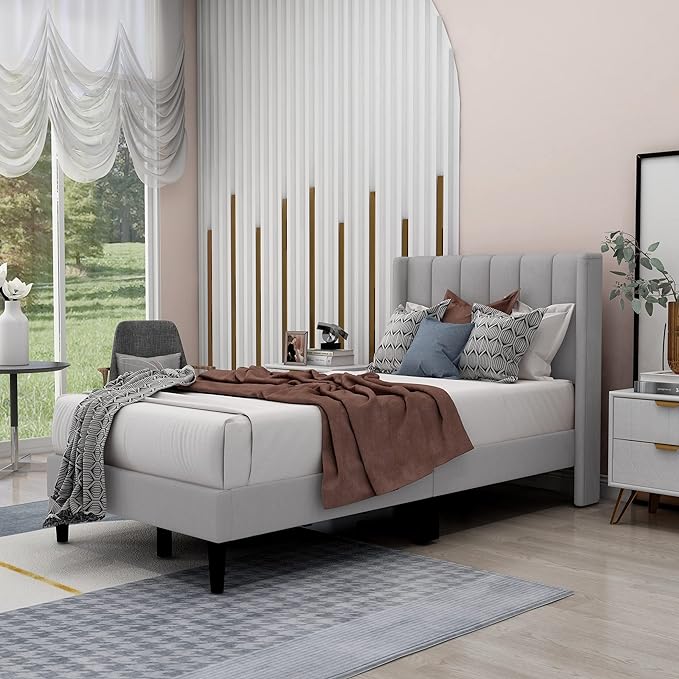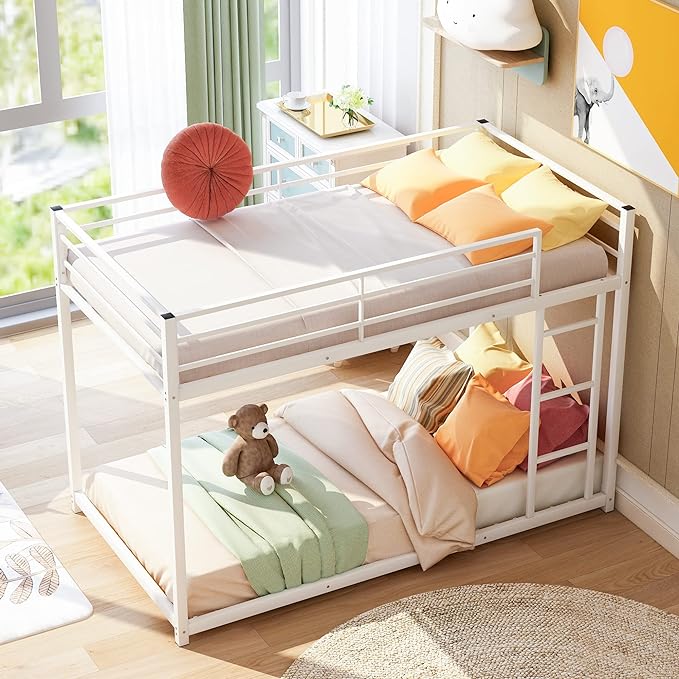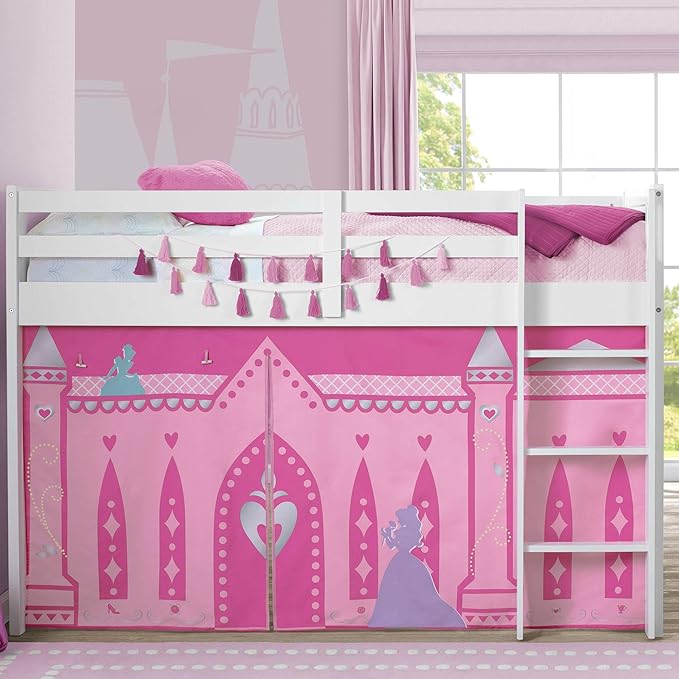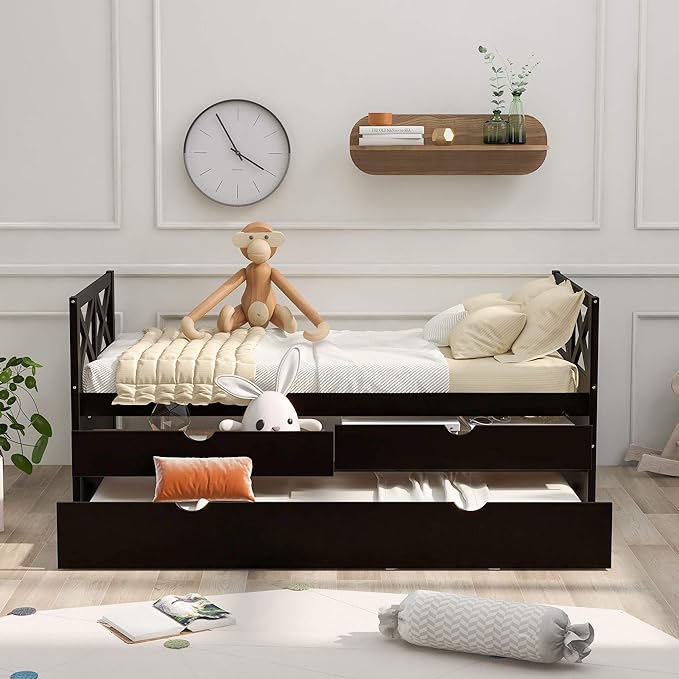As a parent, ensuring your child has a comfortable and safe sleeping environment is paramount. Choosing the right bed frame can make a significant difference in your child’s sleep quality and bedroom experience.
This article reviews the 7 best bed frames for kids, highlighting their features, pros, cons, and what makes them stand out. We’ve included a table for a quick comparison and important notes for your consideration.
Tips for Choosing a Bed Frame for Kids
1. Safety First
- Check for Certification: Ensure the bed frame meets safety standards.
- Sturdy Construction: Look for a bed frame that is well-built and doesn’t wobble.
- Safety Rails: For bunk beds or loft beds, ensure there are adequate safety rails.
2. Consider the Material
- Wooden Frames: Durable and classic, but can be heavy.
- Metal Frames: Generally lighter and may offer a modern look, but check for sharp edges.
3. Size and Space
- Room Size: Choose a bed that fits comfortably in your child’s room, leaving space for play and movement.
- Growth Considerations: Opt for a bed that your child won’t outgrow too quickly.
4. Functionality
- Storage Options: Beds with built-in storage can help keep the room tidy.
- Convertible Designs: Some beds can convert into different sizes or have pull-out options for sleepovers.
5. Comfort and Support
- Mattress Compatibility: Ensure the bed frame is compatible with the mattress you have or plan to buy.
- Even Support: A good bed frame should provide even support to the mattress to ensure a comfortable sleep.
6. Design and Aesthetics
- Theme: Themed bed frames are fun for younger kids but consider how long the theme will be appealing.
- Color and Style: Choose a color and style that matches the room’s decor and your child’s preferences.
7. Ease of Assembly and Maintenance
- Assembly Requirements: Consider how easy it is to assemble the bed frame.
- Cleaning and Upkeep: Look for a bed frame that is easy to clean and maintain.
8. Budget
- Price Range: Determine your budget beforehand and look for the best options within it.
- Long-term Value: Investing a bit more in a quality bed frame can be cost-effective in the long run.
9. Reviews and Recommendations
- User Reviews: Check online reviews to understand the experiences of other buyers.
- Recommendations: Ask friends or family for recommendations based on their experiences.
10. Warranty and Return Policy
- Warranty Period: A longer warranty period can provide peace of mind.
- Return Policy: Understand the return policy in case the bed frame is not as expected.
Tips for Maintaining a Bed Frame for Kids
1. Regular Inspection
- Check for Loose Parts: Periodically tighten screws and bolts to ensure stability.
- Inspect for Damage: Look for any cracks, splits, or damage, especially in wooden frames.
2. Cleaning and Care
- Dust Regularly: Use a soft cloth or duster to keep the frame free of dust.
- Wipe Spills Immediately: Clean any spills or stains as soon as possible to prevent damage.
3. Protecting the Frame
- Use Protective Pads: Consider adding felt pads to the corners to prevent scratches.
- Avoid Stickers and Markers: Encourage kids not to put stickers or use markers on the bed frame.
4. Avoid Excess Weight
- Respect Weight Limits: Don’t exceed the recommended weight limit to prevent strain on the frame.
- Discourage Jumping: Teach children not to jump on the bed to avoid structural damage.
5. Proper Mattress Support
- Check Slats or Box Spring: Ensure they are in good condition and provide proper support to the mattress.
- Replace if Necessary: If slats are broken or a box spring is sagging, replace them to maintain frame integrity.
6. Environmental Considerations
- Avoid Direct Sunlight: Prolonged exposure to sunlight can fade and damage some materials.
- Maintain Humidity Levels: Extreme humidity or dryness can affect wooden frames.
7. Dealing with Squeaks
- Lubricate Joints: If the frame starts squeaking, lubricate the joints and screws with appropriate products.
8. Bedding Maintenance
- Regularly Change Bedding: Keeping bedding clean helps protect the bed frame from dirt and spills.
- Use a Mattress Protector: A protector can safeguard against spills and accidents.
9. Pest Prevention
- Regular Checks for Pests: Particularly with wooden frames, check for signs of termites or other pests.
- Clean Underneath: Regularly clean under the bed to prevent dust and pests.
10. Updating and Upcycling
- Repaint or Refinish: Give an old bed frame a new look with a coat of paint or refinish.
- Add-ons and Modifications: Add storage or safety rails as needed for functionality.
Regular maintenance of your child’s bed frame not only extends its lifespan but also ensures a safe and comfortable sleep environment. Simple steps like tightening screws, cleaning, and avoiding excessive wear can make a big difference.
7 Best Bed Frames for Kids
1. Classic Wooden Frame

Features: Sturdy build, timeless design, available in multiple finishes.
Pros: Durable, easy to match with different decor, safer with no sharp edges.
Cons: Can be heavy, not as customizable.
Perfect for: Kids who need a stable and long-lasting frame.
2. Metal Bunk Bed

Features: Space-saving, sturdy metal construction, safety rails.
Pros: Ideal for siblings, fun design, good for small spaces.
Cons: Higher risk of injuries from climbing, not suitable for very young children.
Important Note: Ensure the top bunk is always equipped with safety rails.
Perfect for: Older kids sharing a room.
3. Themed Bed Frames

Features: Designs ranging from princess castles to race cars, colorful.
Pros: Encourages imagination, makes bedtime fun.
Cons: Can be more expensive, may not be suitable as kids grow older.
Perfect for: Young children with a love for themes and characters.
4. Trundle Bed

Features: A bed with a pull-out secondary bed, space-saving.
Pros: Great for sleepovers, efficient use of space.
Cons: Trundle bed might have a thinner mattress.
Perfect for: Kids who often have friends stay over.
5. Storage Bed

Features: Built-in drawers or shelves.
Pros: Extra storage space, helps keep rooms tidy.
Cons: Can be bulky, more expensive.
Perfect for: Kids with lots of toys or limited space.
6. Adjustable Bed

Features: Head and foot can be raised, some have remote controls.
Pros: Adaptable for different activities like reading, may have health benefits.
Cons: More expensive, complex mechanisms.
Important Note: Choose models with child-safe controls and mechanisms.
Perfect for: Kids with specific health or comfort needs.
7. Loft Bed

Features: Elevated bed with space underneath for desks or play.
Pros: Efficient use of vertical space, promotes a separate study area.
Cons: Not suitable for very young children, requires climbing.
Important Note: Always check the stability and weight capacity.
Perfect for: Older kids in need of a study space.
Comparison Table
| Bed Frame Type | Key Feature | Pros | Cons | Best For |
|---|---|---|---|---|
| Classic Wooden | Timeless design | Durable, safe | Heavy, less fun | Stability, longevity |
| Metal Bunk Bed | Space-saving | Fun, good for roommates | Climbing risk | Siblings |
| Themed | Fun designs | Encourages imagination | Less versatile | Young imaginative kids |
| Trundle | Extra bed | Ideal for sleepovers | Thinner mattress | Frequent guests |
| Storage | Built-in storage | Tidy rooms | Bulky, expensive | Rooms with limited space |
| Adjustable | Customizable positions | Versatile | Complex, pricey | Special comfort needs |
| Loft | Space underneath | Study area, space-saving | Climbing risk | Older kids, small rooms |
Conclusion
When selecting the best bed frame for your child, consider their age, interests, and room size. Safety should always be a top priority, especially for beds that require climbing or have movable parts. A bed frame is more than just a piece of furniture; it’s a key component in your child’s daily life that impacts sleep quality, comfort, and even imagination. Whether you opt for a classic wooden frame or a more adventurous themed bed, ensure it aligns with your child’s needs and your family’s lifestyle.
Remember, the best bed frame for your child is one that combines safety, comfort, and a dash of fun!
Frequently Asked Questions About Bed Frames for Kids
1. What is the best material for a kid’s bed frame?
- Answer: The best material varies based on durability, safety, and style preferences. Common options include solid wood for sturdiness and longevity, and metal for a more lightweight and often cost-effective choice.
2. At what age should I transition my child to a bed frame?
- Answer: Most children transition from a crib to a bed frame between the ages of 18 months and 3 years. However, this can depend on the child’s size, development, and comfort level.
3. How important are safety rails for kids’ bed frames?
- Answer: Safety rails are crucial for preventing falls, especially for younger children or those using a bunk or loft bed. They are highly recommended until the child is older and more aware of their sleeping position.
4. Can bed frames for kids include storage options?
- Answer: Yes, many bed frames for kids come with built-in storage options like drawers or shelves, which can be very useful for saving space and keeping the room organized.
5. How do I choose the right size bed frame for my child?
- Answer: Consider your child’s age, height, and room size. Twin size is standard for younger children, while full or queen sizes can be better for older children and teens.
6. Are themed bed frames a good choice?
- Answer: Themed bed frames can be fun and encourage kids to enjoy their bedrooms. However, keep in mind they might outgrow the theme quickly. Choose themes that can easily be adapted as the child grows.
7. What’s the difference between a standard bed frame and a bunk bed?
- Answer: A standard bed frame is a single-level bed suitable for one person, while bunk beds are two or more beds stacked on top of each other, ideal for sharing a room.
8. How often should I replace my child’s bed frame?
- Answer: This depends on the quality of the bed frame and how well it’s maintained. Generally, a good quality bed frame can last until the child outgrows it or for several years.
9. Is it easy to assemble a kid’s bed frame?
- Answer: Ease of assembly varies by model. Many bed frames come with instructions and can be assembled at home, but some might require professional assistance or more complex assembly.
10. Are adjustable bed frames suitable for children?
- Answer: While less common, adjustable bed frames can be suitable, especially for children with specific health needs. Ensure that any adjustable mechanism is safe and child-friendly.